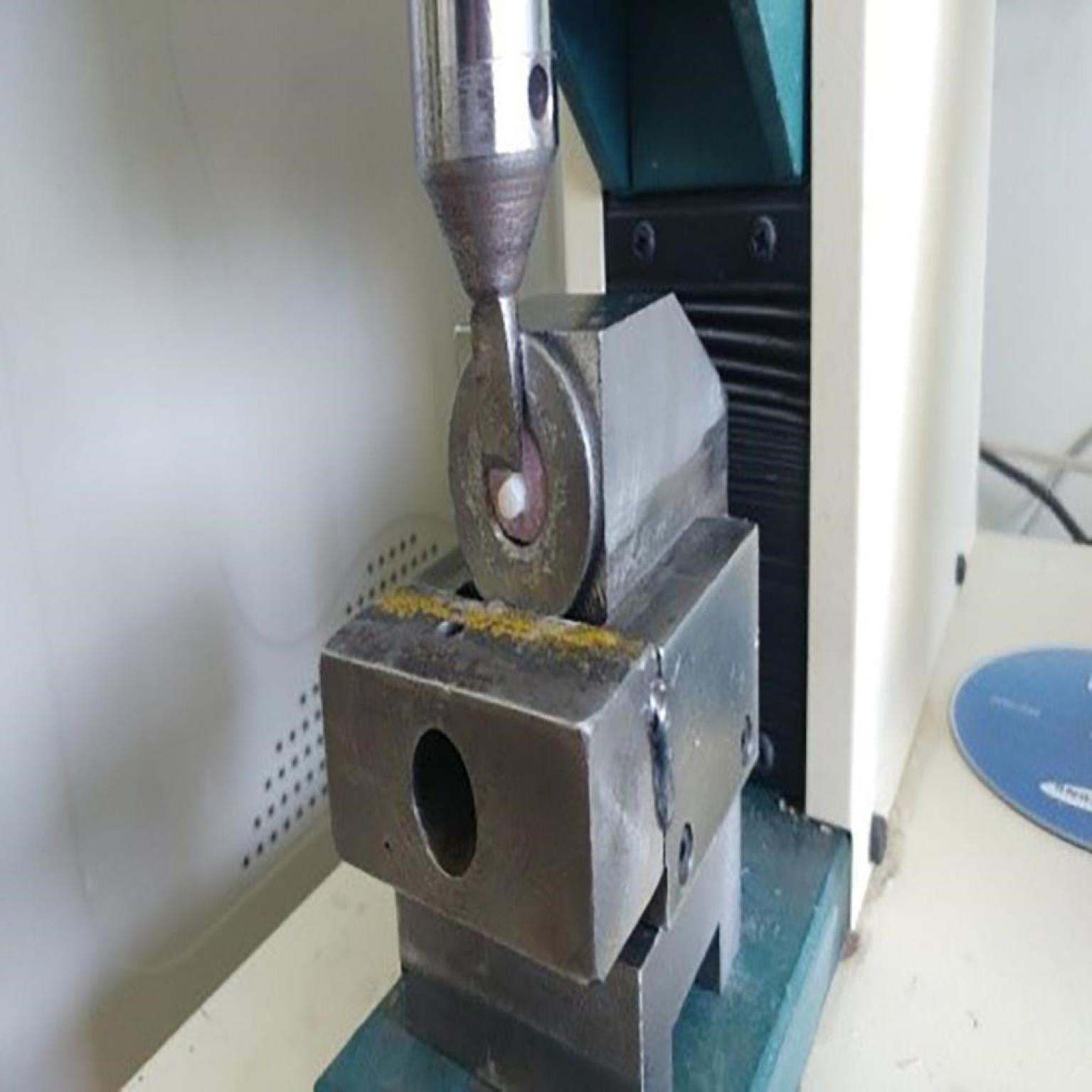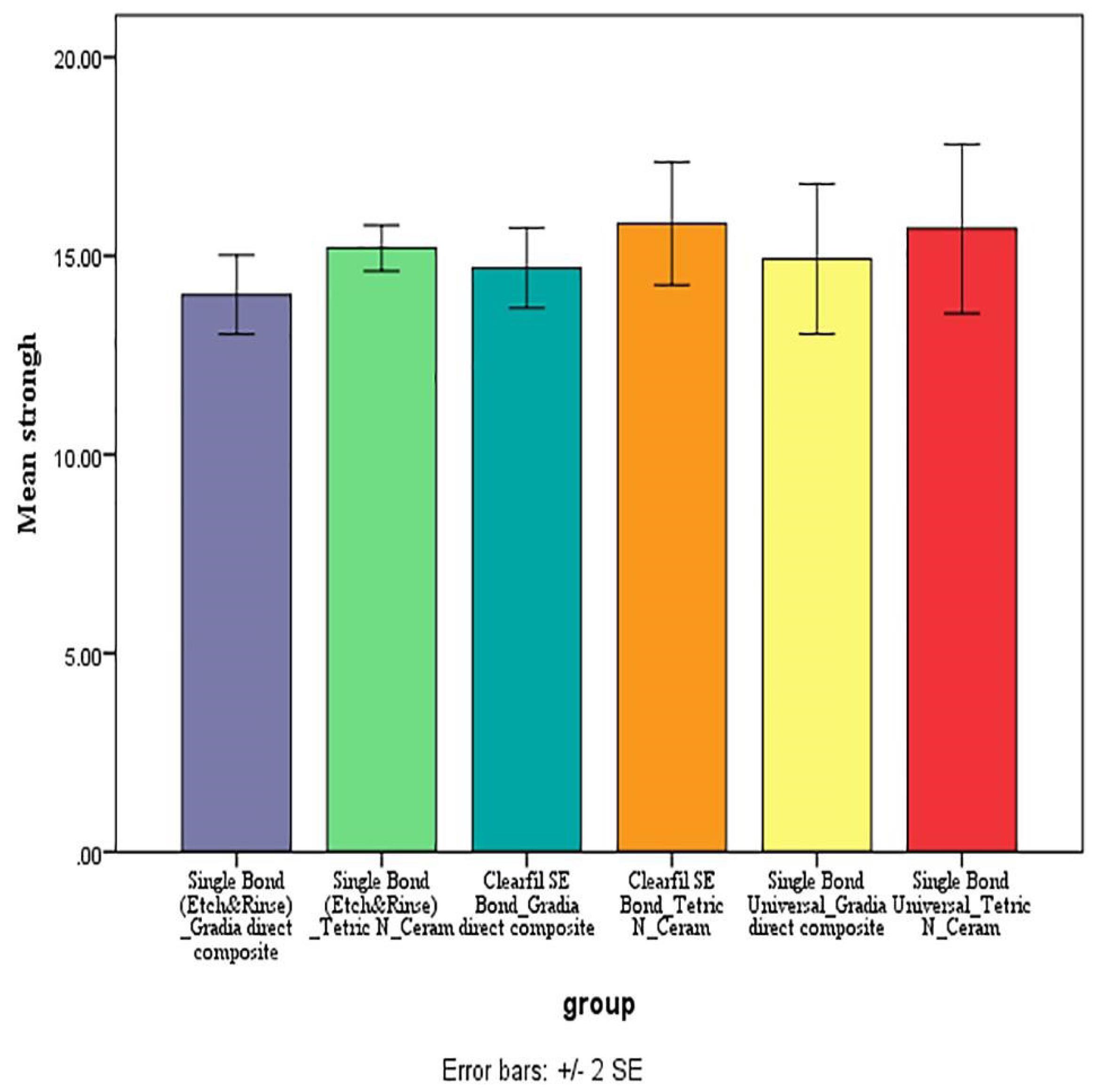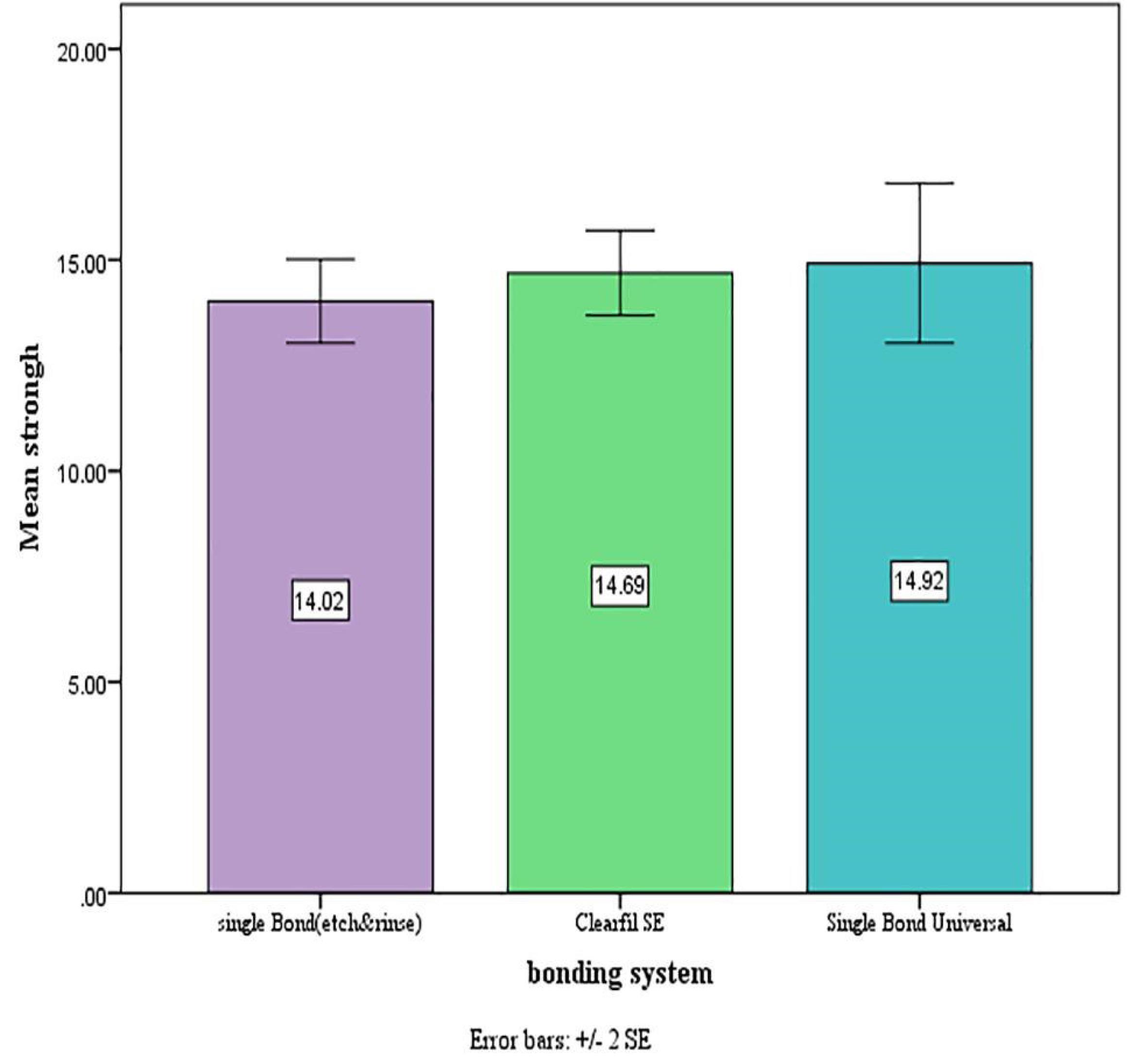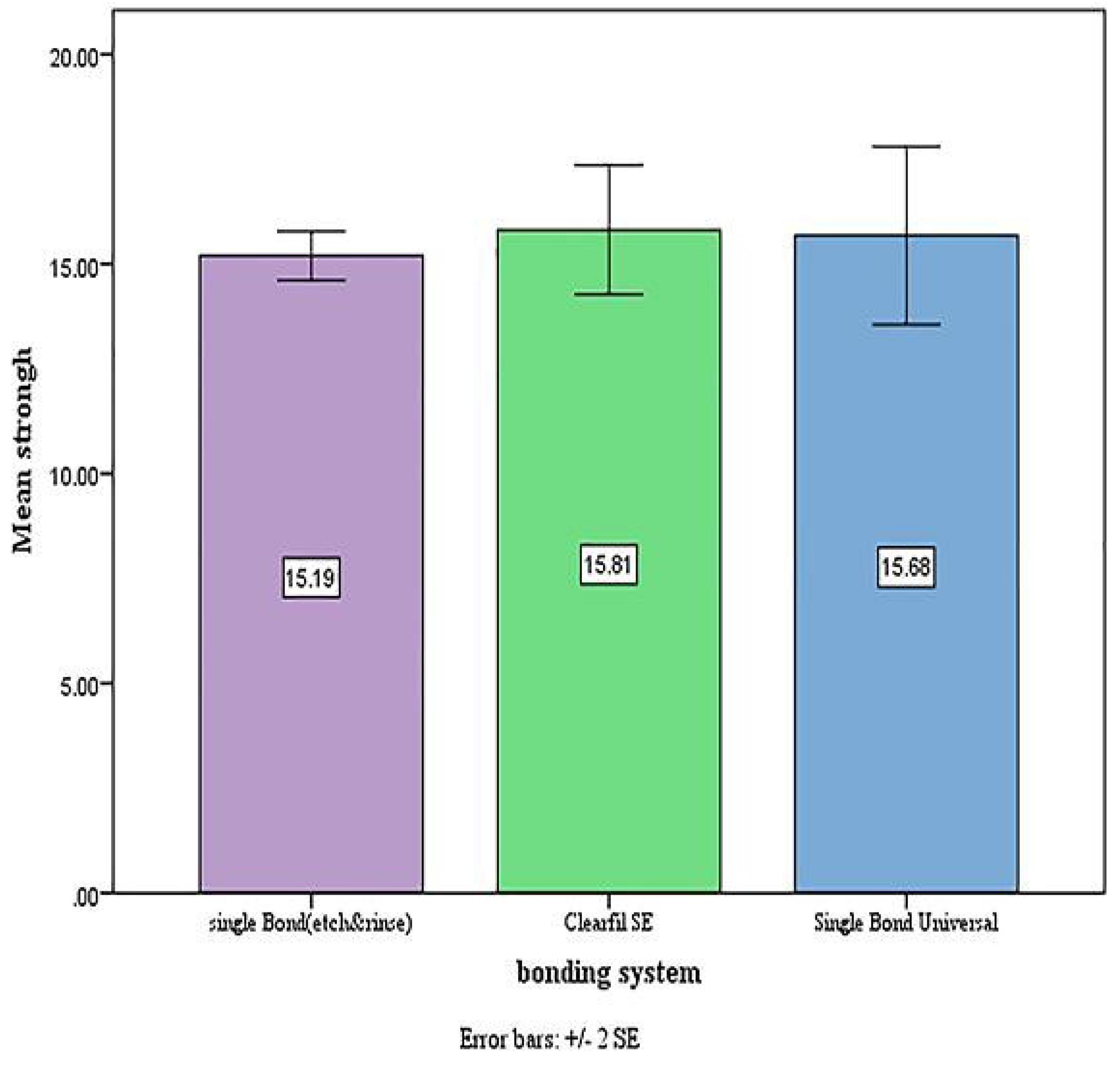Avicenna J Dent Res. 15(3):97-102.
doi: 10.34172/ajdr.1611
Original Article
Comparison of Repair Bond Strength of Bulk-fill and Conventional Composites With Different Bonding Systems
Hafez Vahedpour 1  , Hamid Tavakkoli 2
, Hamid Tavakkoli 2  , Zohreh Mousavi 3, *
, Zohreh Mousavi 3, * 
Author information:
1Assistant Professor, Department of Restorative Dentistry, School of Dentistry, Urmia University of Medical Sciences, Urmia, Iran
2Postgraduate Student, Department of Oral and Maxillofacial Radiology, School of Dentistry, Hamadan University of Medical Sciences, Hamadan, Iran
3Oral & Maxillofacial Radiology,Urmia University of Medical Sciences, Urmia, Iran
Abstract
Background: One of the advantages of resin composites as a restorative material is their repairability. The purpose of the current study was to compare the repair bond strength of conventional and bulk-fill composites with different bonding systems.
Methods: In this in vitro study, sixty cylindrical specimens of materials were prepared according to the six groups under study (two types of conventional Gradia Direct and N-Ceram Bulk-Fill Tetric composites and three bonding systems: Single Bond Universal and Clearfil SE Bond and Single Bond 2). The samples were divided into 6 groups of 10 Single Bond/Gradia Direct composite (G1), Single Bond/Tetric N-Ceram bulk-fill composite (G2), Clearfil SE bond/Gradia Direct (G3), Clearfil SE Bond/Tetric N-Ceram bulk-fill composite (G4), single bond universal/Gradia Direct composite (G5), and Single Bond Universal/Tetric N-Ceram bulk-fill composite (G6). Repair bond strength in each group was measured using the Universal Testing Machine (Hounsfield). All data were analyzed by SPSS 21 using ANOVA, Student’s t-test, and chi-square statistical tests (P<0.05).
Results: The highest and lowest bond strength (15.81±2.44 and 14.02±1.57, respectively) belonged to the Clearfil SE Bond-Tetric N-Ceram and Single Bond (Etch & Rinse)-Gradia Direct groups, respectively. The ANOVA test results demonstrated no significant difference in the bonding strengths of the study groups (P=0.537).
Conclusions: Bulk-fill composite Tetric N-Ceram, apart from the bonding system, had higher repair bond strength compared to the conventional Gradia Direct composite. It seems that self-etch bonding systems (Clearfil SE Bond and Single Bond Universal) have had more bond strength than etch and rinse bonding (Single Bond 2 bonds).
Keywords: Bulk-fill composite, Conventional composites, Shear bond strength
Copyright and License Information
© 2023 The Author(s); Published by Hamadan University of Medical Sciences.
This is an open-access article distributed under the terms of the Creative Commons Attribution License (
http://creativecommons.org/licenses/by/4.0), which permits unrestricted use, distribution, and reproduction in any medium provided the original work is properly cited.
Please cite this article as follows: Vahedpour H, Tavakkoli H, Mousavi Z. Comparison of repair bond strength of bulk-fill and conventional composites with different bonding systems. Avicenna J Dent Res. 2023; 15(3):97-102. doi:10.34172/ajdr.1611
Background
Currently, composite restorations have the benefits of general clinical applications that apply to almost all dental sites and for any restorative treatment. The bonding ability of these materials to dental tissues (dentin and enamel) and their physical properties have led to their extensive use (1,2).
Progress in bonding technology has made it easier for dentists to do esthetic treatments in more conservative and economic ways (3). Similar to other restorations, the composites fail and require replacement and repair. Factors such as extent, location and quality of existing restoration, life expectancy, and cost are all effective factors in choosing repair/replacement for final treatment (4,5). Repairing is preferred to replacement because it is more conservative and less harmful to the pulp.
The repairability can be evaluated by the bond strength between the surface of the first layer and the new layer in the restoration (6). Nowadays, bulk-fill composites are used in addition to conventional composites that are layered in the cavity. Conventional composites have high viscosity and are incrementally employed in 1-2 mm layers for better adaptation to cavity walls.
However, bulk-fill composites have specific properties such as increased fluidity, to achieve greater adaptation with the cavity, lower elasticity and polymerization shrinkage, and lower microleakage when they are placed in the cavity in 4-5 mm layers (6,7). Dentin bonding systems are used for bonding the composite to the teeth.
Poor bonding and difficulty of application processes of dentin bonding systems have undesirable consequences such as increasing technical sensitivity and thus working errors, waste of time, dental discoloration due to recurrent caries around the restoration, and eventually the loss of restoration (7,8).
There are various inconsistencies about the best type of bonding agent in terms of microleakage and shear bond strength, and each study has introduced a type of bonding with higher bond strength (6-9). This study aimed to compare the repair bond strength of conventional and bulk-fill composites performed with different bonding systems.
Materials and Methods
In this in vitro study, which was performed on conventional and bulk-fill composites, the samples were divided into 6 groups of 10 as follows:
Single Bond/Gradia Direct composite (G1), Single Bond/Tetric N-Ceram bulk-fill composite (G2), Clearfil SE Bond/Gradia Direct (G3), Clearfil SE Bond/Tetric N-Ceram bulk-fill composite (G4), Single Bond Universal/Gradia Direct composite (G5), and Single Bond Universal/Tetric N-Ceram bulk-fill composite (G6).A pre-designed observation checklist tool was used to record the results.
Sample Preparation
Sixty cylindrical composite specimens (5 mm diameter and 3 mm height) were fabricated from two types of conventional composites Gradia Direct A2 shade (GC-Japan) and bulk-fill Tetric N-Ceram A2 shade (Ivoclar-Switzerland) using a plastic mold. Gradia Direct composite was incrementally placed in 1.5 mm layers inside the mold. The first layer was cured for 40 seconds at an intensity of 450 mW using the D-Lux (DiaDent, South Korea) light curing device.
On the second layer, a clear celluloid strip and a slide glass were placed on the composite and then pressed, and the light was perpendicularly applied for 40 seconds.
However, the bulk-fill Tetric N-Ceram (Ivoclar, Switzerland) composite was placed in a 3 mm layer. Again the upper surface was covered with a celluloid strip and a slide glass with compression, and the light was applied as previous.
The specimens were stored in distilled water for two weeks in the aging process. Then, thermocycling was performed for all samples 5000 times at 5-55 ± 2°C with 30-second intervals.
The upper surface of the specimens was roughened by a high-speed handpiece with water coolant in sweeping motions. Number 8811012 diamond burs (Diatech TOP diamonds, Switzerland 25) used for it (Diatech TOP diamonds, Switzerland 25). On all specimens, 37% phosphoric acid (SDI Australia super etch) was applied (SDI Australia super etch) for 15 seconds and then washed for 15 seconds with water spray and dried for 10 seconds.
Preparation of Samples in Different Bonding Groups
For two groups (one group of conventional composites and one group of bulk-fill composites), Single Bond 2 (Etch & Rinse) bonding was applied on the surface by mini-brushes according to the manufacturer’s instructions. Next, it was air-dried for 30 seconds, and the second layer was applied and air-dried, and finally light cured for 10 seconds. Clearfil SE Bond (6th generation) was applied to the next two groups according to the manufacturer’s instructions. First, the surface of the specimens was impregnated with Clearfil SE primer for 20 seconds and air-dried for 3 seconds. Then, a mini-brush Clearfil bond was applied on the surface and air-dried for 3 seconds and eventually, cured for 10 seconds. Single bond Universal bonding for the last two groups was applied to the sample surface by a small brush for 20 seconds according to the manufacturers’ instructions, air-dried for 5 seconds, and ultimately, cured for 10 seconds. Finally, each sample was transferred to a two-piece mold, and the new composite (of the same type but with a different color), similar to the previous step (two 1.5 mm layers for Gradia Direct and one 3 mm layer for Tetric N-Ceram), was placed on the old composite and light cured.
Shear Bond Strength
All prepared specimens were mounted in self-cure acrylic blocks (Acropars, Iran) up to the junction of old-new composites. Finally, the samples were placed in the Universal Testing Machine (Hounsfield), and the shear force was applied at a speed of 0.5 mm/minute through a straight-edge chisel to the old-new composite junction until the specimens were broken (Figure 1).

Figure 1.
Shear Force Applied to the Old-New Composite Junction in the Universal Machine
.
Shear Force Applied to the Old-New Composite Junction in the Universal Machine
Shear bond strength in MPa was calculated by dividing the fracture force (Newton) by the cross-sectional area (mm2) of the specimens. All data were analyzed by SPSS software (Version 21), as well as analysis of variance (ANOVA), Student’s t-test and chi-square statistical tests at a significance level of P < 0.05.
Results
The average bond strength of all six study groups is provided in Table 1. In Single Bond 2 (Etch and rinse) groups, the average repair bond strength in the Tetric N-Ceram composite was significantly higher than the strength in the Gradia Direct composite (P = 0.056). However, the bond strength of the two composites was not significantly different in Clearfil SE Bond (P = 0.24) and Single Bond Universal (P = 0.600) groups.
Table 1.
Comparison of Average Bond Strength According to the Type of the Bonding System in Each Composite Group
|
Bonding System
|
Composite
|
Number
|
Mean
|
Standard Deviation
|
P
Value
|
| Single Bond (Etch and rinse) |
Gradia Direct Composite |
10 |
14.02 |
1.57 |
0.056 |
| Tetric N-Ceram |
10 |
15.19 |
0.92 |
| Clearfil SE |
Gradia Direct Composite |
10 |
14.69 |
1.60 |
0.240 |
| Tetric N-Ceram |
10 |
15.81 |
2.44 |
| Single Bond Universal |
Gradia Direct composite |
10 |
14.92 |
2.99 |
0.600 |
| Tetric N-Ceram |
10 |
15.68 |
3.36 |
Based on data in Table 1, the highest and lowest bond strength (15.81 ± 2.44 and 14.02 ± 1.57) were related to the Clearfil SE Bond-Tetric N-Ceram and Single Bond (Etch & Rinse) Gradia Direct groups, respectively. A comparison of the mean bond strength between the six groups (Figure 2) using the ANOVA test represented that there was no significant difference (P = 0.537).

Figure 2.
Comparison of the Average Bond Strength in Study Groups
.
Comparison of the Average Bond Strength in Study Groups
Comparing the bonding systems in each composite group, the average bond strength in Gradia Direct composite groups, from high to low, belonged to the Single Bond Universal, Clearfil SE, and Single Bond 2 (Etch & Rinse) groups, but no statistically significant difference was observed between them (Figure 3).

Figure 3.
Comparison of the Average Bond Strength in Gradia Direct Composite
.
Comparison of the Average Bond Strength in Gradia Direct Composite
Additionally, in the composite Tetric N-Ceram groups, the order of the average bond strength values was Single Bond Universal, Clearfil SE, and Single Bond 2 (Etch & Rinse), and this difference was not statistically significant (Figure 4).

Figure 4.
Comparison of Average Bond Strength in Tetric N-Ceram Composite
.
Comparison of Average Bond Strength in Tetric N-Ceram Composite
According to the results of Table 2, the highest frequency of adhesion failure and the highest frequency of cohesive failure belonged to the Gradia Direct-Clearfil SE and Clearfil SE Tetric N-Ceram groups, respectively. Further, the highest frequency of mixed failure was related to the Single Bond 2 Tetric-N-Worm group. There was no significant difference (P > 0.05) in fracture type distribution in the study groups.
Table 2.
Comparison of Frequency of Fracture Types by Study Groups
|
Bonding System
|
Composite
|
Number
|
Adhesion Failure
|
Cohesive Failure
|
Mixed Failure
|
| Single Bond (Etch and rinse) |
Gradia Direct composite |
10 |
6 |
2 |
2 |
| Tetric N-Ceram |
10 |
5 |
1 |
4 |
| Clearfil SE |
Gradia Direct composite |
10 |
7 |
0 |
3 |
| Tetric N-Ceram |
10 |
4 |
4 |
2 |
| Single Bond Universal |
Gradia Direct composite |
10 |
6 |
3 |
1 |
| Tetric N-Ceram |
10 |
6 |
2 |
2 |
Discussion
In this study, two types of composites, namely, a conventional composite (Gradia Direct) and a bulk-fill (Tetric N-Ceram) composite were used, and the new and old composites were considered identical in different colors to distinguish the boundary between the new and the old one. In most studies, the old and new composites have also been considered the same (2,4,5). The composite specimens were incubated in distilled water at 37°C (body temperature) for two weeks. The highest residual free radical activity at the composite surface is in the first 24 hours after polymerization (5,6). Thus, within 14 days, the activity of free radicals in the functional groups of the resin represented a significant reduction.
On the other hand, by keeping the samples in a humid environment, hydrolytic degradation and hydrolysis and oxidation reactions, including those occurring in the oral cavity, are possible (7). In general, the repair bond strength of the old composite is affected by factors such as aging conditions, elapsed time after the repair, type of composite, surface roughness, and bonding strength (10). For the aging process, various methods such as boiling, thermocycling, and keeping in citric acid, sodium chloride, and distilled water have been used in various studies. However, water is the most common storage, with varying storage times from 24 hours to 6 months (11-13). The current study investigated the effects of three types of Single Bond Universal and Clearfil SE Bond and Single Bond 2 (Etch & Rinse) bonding systems on two conventional composites, namely, Gradia Direct (GC-Japan) and bulk-fill Tetric N-Ceram (Ivoclar, Switzerland). Considering that in in vivo conditions, before applying bonding agents, cleaning of the composite surface is required due to plaque formation and saliva contamination (3), 37% phosphoric acid was used to clean the specimens. Several studies employed phosphoric acid for this purpose, but their results confirmed its ineffective in vitro to increase bond strength (10). The results of the present study demonstrated that the repair bond strength in the Tetric N-Ceram composite group with the Clearfil SE bonding system was the highest, and the lowest bonding strength belonged to the Gradia Direct composite group with the Single Bond 2 (Etch & Rinse) bonding system. The results also showed that in all groups with different bonding systems (three bonding systems under investigation), the Tetric N-Ceram composite had higher bond strength than the Gradia Direct composite, representing no significant difference compared with statistical tests. To the best of our knowledge, no similar studies were found to compare the repair bond strength of conventional and bulk-fill composites. Many studies have highlighted the importance of bonding agents in increasing bond strength (14-17). Two possible mechanisms in the bonding agent’s performance are the chemical bonding with composite and the penetration of the monomers into surface matrix irregularities and the mechanical retention inside it (17). The solvent in the bonding agent causes swelling and gelatinization of the surface layer and allows the monomer to penetrate (9). There are contradictory results about the efficiency of Etch and Rinse and self-etch systems in repairing composites without the use of silane. In the current study, the results of the Clearfil SE bond group were higher than the Single Bond 2 (etch and rinse) group in both composite groups. Moreover, in the bulk-fill group, Clearfil SE had the highest bond strength, which was not statistically significant. Cavalcanti et al (18) also found that the self-etch bonding system (Clearfil SE bond) was better than the Etch and Rinse system (Single bond), which is consistent with the findings of the current study. Probably one of the reasons for the better results of Clearfil SE Bond is the presence of 10-MDP monomeric acid (10-Methacryloyloyloxydecyl dihydrogen phosphate) in its composition and the penetration of these acidic monomers into the old composite. Additionally, the polarity of the phosphate groups of this monomer may help bond with inorganic composite filler particles (19). On the other hand, the difference in bond strength between these two bonding systems can be attributed to the presence of fillers in the Clearfil SE bond. It has been represented that the bond strength increases by increasing the filler content in the bonding agent (20).
In a study by Pradelle-Plasse et al, there was a significant difference, while no statistical preference was found among the self-etching adhesive and Prompt L-Pop and OptiBond Solo (17), which is in line with the findings of the current study. In this study, the shear bond strength of Single Bond Universal (self-etch) was higher than that of Clearfil SE Bond and Single Bond 2 (Etch & Rinse) in the conventional Gradia Direct composite (GC-Japan) group. In their study aiming at investigating the repair bond strength of composite with Universal Adhesive bondings with and without silane, Çakir et al concluded that Single Bond Universal had greater bond strength (21), which conforms to the findings of the current study. Probably one of the reasons for the better results of Single Bond Universal could be the presence of 10-MDP acidic monomer in its composition and the penetration of this acidic monomer into the old composite. The presence of silane in the Single Bond Universal can also be another reason for this result, since silane is a molecule that increases wettability and is capable of bonding with composite filler particles and methacrylate groups. In addition, it acts as an intermediate between the composite and the bonding agent (22). Since silane is able to form chemical bonds with silica composite particles, with more filler exposure, the amount of silane bond will increase with it. Teixeira et al found that etch and rinse (Prime & Bond NT) is more efficient than self-etching, system link adper prompt L-Pop, Tyrian One-Step Plus, Xeno III (23), which is inconsistent with the results of the present study. The difference in the types of bonding systems, composites, storage environment, and shelf life of the samples in the two studies could be a logical reason for this disagreement.
The current study, due to variations in the composite type (two types) and bonding systems (3 systems), had group diversity that allowed for multiple comparisons, which is less observed in the other similar studies, and observation of measurement methods and the standard study process was the other advantage. However, the low sample volume was probably a disadvantage for each group, lowering the study’s ability to better explain the differences. Therefore, it is suggested that in future studies, while increasing the sample volume and considering the other effective factors (common bonding systems, composites, and cost consideration), this study should be performed in a wider scope. It is also possible to cross-examine groups by considering different brands and types of composites (old and new) to assist in the clinical decision.
Conclusion
Bulk-fill composite (Tetric N-Ceram), apart from the bonding system type, had more repair bond strength than the conventional composite (Gradia Direct), but this difference was not statistically significant. In addition, compared to bonding systems, self-etch bonding systems (Clearfil SE Bond and Single Bond Universal) appeared to be more strong than etch and rinse bonding (Single Bond 2), which was not statistically significant. More studies in this field will be effective in making better decisions and considering other components, including the time required for treatment and cost, as well as the technical issues involved in choosing the best method and material.
Authors’ Contribution
Conceptualization: Zohreh Mousavi.
Data curation: Zohreh Mousavi, Hafez Vahedpour.
Formal analysis: Hamid Tavakkoli.
Funding acquisition: Hafez Vahedpour.
Investigation: Zohreh Mousavi, Hafez Vahedpour.
Methodology: Hafez Vahedpour.
Project adminstration: Hafez Vahed Pour.
Resources: Hafez Vahed Pour, Zohreh Mousavi.
Supervision: Zohreh Mousavi.
Validation: Hafez Vahed Pour.
Visualition: Hamid Tavakkoli.
Writing–original draft: Zohreh Mousavi.
Writing–review & editing: Hafez Vahed Pour
Competing Interests
There is no conflict of interest to declare.
Ethical Approval
Not applicable.
Funding
This study did not receive any specific grant from funding agencies in the public, commercial, or not-for-profit sectors.
References
- Ritter AV. Sturdevant’s Art & Science of Operative Dentistry-E-Book. Elsevier Health Sciences; 2017.
- Kussano CM, Bonfante G, Batista JG, Pinto JH. Evaluation of shear bond strength of composite to porcelain according to surface treatment. Braz Dent J 2003; 14(2):132-5. doi: 10.1590/s0103-64402003000200011 [Crossref] [ Google Scholar]
- Summitt JB, Robbins JW, Schwartz RS. Fundamentals of Operative Dentistry: A Contemporary Approach. 2nd ed. Chicago: Quintessence Publishing; 2001.
- Althoff O, Hartung M. Advances in light curing. Am J Dent 2000; 13(Spec No):77D-81D. [ Google Scholar]
- Yap AU, Wang HB, Siow KS, Gan LM. Polymerization shrinkage of visible-light-cured composites. Oper Dent 2000; 25(2):98-103. [ Google Scholar]
- Garcia D, Yaman P, Dennison J, Neiva G. Polymerization shrinkage and depth of cure of bulk fill flowable composite resins. Oper Dent 2014; 39(4):441-8. doi: 10.2341/12-484-l [Crossref] [ Google Scholar]
- Watts DC, Cash AJ. Determination of polymerization shrinkage kinetics in visible-light-cured materials: methods development. Dent Mater 1991; 7(4):281-7. doi: 10.1016/s0109-5641(05)80030-2 [Crossref] [ Google Scholar]
- Li Y, Sun X, Chen J, Xiong J, Hu X. Polymerization shrinkage/stress and dentin bond strength of silorane and dimethacrylate‐based dental composites. J Appl Polym Sci 2012; 124(1):436-43. doi: 10.1002/app.35109 [Crossref] [ Google Scholar]
- Sideridou ID, Achilias DS. Elution study of unreacted Bis-GMA, TEGDMA, UDMA, and Bis-EMA from light-cured dental resins and resin composites using HPLC. J Biomed Mater Res B Appl Biomater 2005; 74(1):617-26. doi: 10.1002/jbm.b.30252 [Crossref] [ Google Scholar]
- Fawzy AS, El-Askary FS, Amer MA. Effect of surface treatments on the tensile bond strength of repaired water-aged anterior restorative micro-fine hybrid resin composite. J Dent 2008; 36(12):969-76. doi: 10.1016/j.jdent.2008.07.014 [Crossref] [ Google Scholar]
- Özel Bektas Ö, Eren D, Herguner Siso S, Akin GE. Effect of thermocycling on the bond strength of composite resin to bur and laser treated composite resin. Lasers Med Sci 2012; 27(4):723-8. doi: 10.1007/s10103-011-0958-2 [Crossref] [ Google Scholar]
- Bonstein T, Garlapo D, Donarummo J Jr, Bush PJ. Evaluation of varied repair protocols applied to aged composite resin. J Adhes Dent 2005; 7(1):41-9. [ Google Scholar]
- Brendeke J, Ozcan M. Effect of physicochemical aging conditions on the composite-composite repair bond strength. J Adhes Dent 2007; 9(4):399-406. [ Google Scholar]
- Ozcan M, Cura C, Brendeke J. Effect of aging conditions on the repair bond strength of a microhybrid and a nanohybrid resin composite. J Adhes Dent 2010; 12(6):451-9. doi: 10.3290/j.jad.a17857 [Crossref] [ Google Scholar]
- Yap AU, Sau CW, Lye KW. Effects of aging on repair bond strengths of a polyacid-modified composite resin. Oper Dent 1999; 24(6):371-6. [ Google Scholar]
- Padipatvuthikul P, Mair LH. Bonding of composite to water aged composite with surface treatments. Dent Mater 2007; 23(4):519-25. doi: 10.1016/j.dental.2006.03.010 [Crossref] [ Google Scholar]
- Pradelle-Plasse N, Nechad S, Tavernier B, Colon P. Effect of dentin adhesives on the enamel-dentin/composite interfacial microleakage. Am J Dent 2001; 14(6):344-8. [ Google Scholar]
- Cavalcanti AN, De Lima AF, Peris AR, Mitsui FH, Marchi GM. Effect of surface treatments and bonding agents on the bond strength of repaired composites. J Esthet Restor Dent 2007; 19(2):90-8. doi: 10.1111/j.1708-8240.2007.00073.x [Crossref] [ Google Scholar]
- Shahdad SA, Kennedy JG. Bond strength of repaired anterior composite resins: an in vitro study. J Dent 1998; 26(8):685-94. doi: 10.1016/s0300-5712(97)00044-4 [Crossref] [ Google Scholar]
- Roberson T, Heymann HO, Swift EJ Jr. Sturdevant’s Art and Science of Operative Dentistry. Elsevier Health Sciences; 2006.
- Çakir NN, Demirbuga S, Balkaya H, Karadaş M. Bonding performance of universal adhesives on composite repairs, with or without silane application. J Conserv Dent 2018; 21(3):263-8. doi: 10.4103/jcd.jcd_11_18 [Crossref] [ Google Scholar]
- Staxrud F, Dahl JE. Silanising agents promote resin-composite repair. Int Dent J 2015; 65(6):311-5. doi: 10.1111/idj.12188 [Crossref] [ Google Scholar]
- Teixeira EC, Bayne SC, Thompson JY, Ritter AV, Swift EJ. Shear bond strength of self-etching bonding systems in combination with various composites used for repairing aged composites. J Adhes Dent 2005; 7(2):159-64. [ Google Scholar]